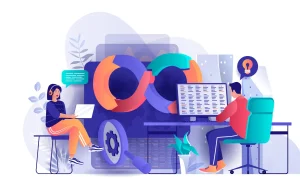Understanding the Mechanics Behind How Artificial Intelligence Functions
Understanding How ChatGPT Works
When you enter a question into ChatGPT, its rapid response can make it seem like you’re chatting with a human. However, behind this instant reply is a sophisticated process involving mathematics, probabilities, and extensive training data. Let’s simplify the complexities of this technology step by step.
The Core Idea: Predicting the Next Word
At its core, a large language model (LLM) like ChatGPT doesn’t possess human-like thought or understanding. Instead, it predicts the next word in a sentence by analyzing patterns from the text it has processed during training.
For instance, if you begin a sentence with “The cat sat on the…,” the model infers that the next word is likely “mat.” While it lacks understanding of what a cat or mat is, it reflects statistical correlations based on countless similar examples in its training data. This predictive process occurs one token at a time (where a “token” can be a word or part of a word) until a coherent response is generated.
Training on Massive Amounts of Text
Before ChatGPT can produce a single response, it undergoes extensive training on a vast array of text from sources like books, websites, and research papers. This enables the model to grasp grammar, facts, and the nuanced rhythm of human conversation.
During training, the model analyzes text segments, concealing a few words to predict what’s missing. Each time it makes an incorrect prediction, it adjusts its millions of underlying parameters, honing its ability with each iteration. This repetitive process, executed billions of times, teaches the model the intricacies of language.
Neural Networks: The Brain Behind ChatGPT
The architecture that powers ChatGPT is known as a Transformer, a specialized neural network adept at understanding the relationships between words and their context. Unlike traditional models that read sentences in sequence, the Transformer simultaneously evaluates all words. This mechanism, called attention, allows the model to focus on the most significant parts of the text for accurate predictions.
The attention feature enhances the naturalness and accuracy of modern language models, setting them apart from their predecessors.
From Probability to Personality
When it generates sentences, ChatGPT doesn’t merely choose one “correct” answer. Instead, it examines various possible follow-up words, each with a certain probability. By sampling from these probabilities, it creates text that feels natural and diverse.
This variability explains why two responses to the same question may differ slightly. The degree of randomness, controlled by a parameter known as temperature, fosters creativity—lower temperatures yield factual and consistent responses, while higher settings result in more imaginative or unpredictable outputs.
The Human Touch: Fine-Tuning and Safety
After its initial training phase, ChatGPT moves into fine-tuning. In this stage, it learns to adhere to instructions, maintain politeness, and stick to the topic. Human reviewers play a crucial role in this process, evaluating various AI responses and teaching the model what constitutes helpful, safe, and appropriate communication.
This fine-tuning is what transforms a basic language model into a user-friendly conversational partner, akin to ChatGPT.
What It Means for Everyday Use
Gaining an understanding of how LLMs like ChatGPT operate helps demystify the technology. Although ChatGPT does not think in the human sense, it excels in recognizing context and mimicking language patterns effectively.
When you pose a question, you’re activating a statistical engine finely tuned to patterns of knowledge and conversation—a digital echo of how humans articulate thoughts and ideas. So next time you receive a thoughtful answer from ChatGPT, remember that it’s not reading your mind; it’s predicting responses one word at a time with impressive accuracy.
How Does Midjourney Generate Images?
While ChatGPT focuses on creating text, Midjourney specializes in image generation. Yet, both models share a fundamental similarity: they learn patterns from vast datasets. The primary distinction lies in the nature of these patterns. ChatGPT learns the structure of language, while Midjourney grasps the aesthetics of visuals.
The Contrast Between Text and Visual Models
The mechanics used in generating text versus images entail different methodologies and frameworks. Language models like ChatGPT rely on semantic and grammatical structures. In contrast, visual models like Midjourney interpret color, shape, and form to create images.
For example, while ChatGPT may analyze how words fit together in a sentence, Midjourney examines how different visual elements harmonize in an image. Both processes involve immense datasets but are specialized to cater to their respective outputs—text or imagery.
The Future of AI Interactions
As advancements in machine learning continue, both text and image generators are becoming increasingly nuanced and capable. The end goal is to create systems that not only mirror human interactions but also enhance productivity and creativity in various fields.
In various sectors, from customer service to content creation, understanding these AI capabilities can revolutionize how we engage with technology. As people become familiar with these tools, their applications will expand, fostering even more innovative ways to communicate and create.
Conclusion: The Journey Ahead
As we move forward in the age of AI, understanding how models like ChatGPT and Midjourney function provides insight into our interactions with technology. These tools are not just sophisticated algorithms; they represent a significant leap in how we process and generate language and images.
By demystifying the process behind these models, we can better appreciate their capabilities and limitations, fostering a more informed relationship with artificial intelligence. Whether generating text or creating stunning visuals, the potential of AI remains boundless, offering exciting opportunities for the future.
Thanks for reading. Please let us know your thoughts and ideas in the comment section down below.
Source link
#work #Blog






